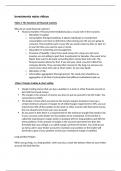Samenvatting
Samenvatting 'Sociale Omgeving & Gedrag'
- Instelling
- Rijksuniversiteit Groningen (RuG)
This document is a summary of the book of the course Social environment and Behavior, PSBA2-04/PSBE2-04. It is a summary of the entire book.
[Meer zien]














